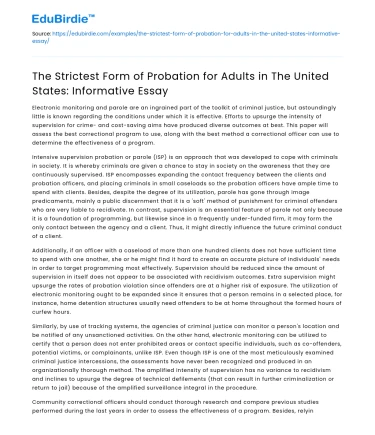Electronic monitoring and parole are an ingrained part of the toolkit of criminal justice, but astoundingly little is known regarding the conditions under which it is effective. Efforts to upsurge the intensity of supervision for crime- and cost-saving aims have produced diverse outcomes at best. This paper will assess the best correctional program to use, along with the best method a correctional officer can use to determine the effectiveness of a program.
Intensive supervision probation or parole (ISP) is an approach that was developed to cope with criminals in society. It is whereby criminals are given a chance to stay in society on the awareness that they are continuously supervised. ISP encompasses expanding the contact frequency between the clients and probation officers, and placing criminals in small caseloads so the probation officers have ample time to spend with clients. Besides, despite the degree of its utilization, parole has gone through image predicaments, mainly a public discernment that it is a 'soft' method of punishment for criminal offenders who are very liable to recidivate. In contrast, supervision is an essential feature of parole not only because it is a foundation of programming, but likewise since in a frequently under-funded firm, it may form the only contact between the agency and a client. Thus, it might directly influence the future criminal conduct of a client.
Save your time!
We can take care of your essay
- Proper editing and formatting
- Free revision, title page, and bibliography
- Flexible prices and money-back guarantee
Additionally, if an officer with a caseload of more than one hundred clients does not have sufficient time to spend with one another, she or he might find it hard to create an accurate picture of individuals' needs in order to target programming most effectively. Supervision should be reduced since the amount of supervision in itself does not appear to be associated with recidivism outcomes. Extra supervision might upsurge the rates of probation violation since offenders are at a higher risk of exposure. The utilization of electronic monitoring ought to be expanded since it ensures that a person remains in a selected place, for instance, home detention structures usually need offenders to be at home throughout the formed hours of curfew hours.
Similarly, by use of tracking systems, the agencies of criminal justice can monitor a person's location and be notified of any unsanctioned activities. On the other hand, electronic monitoring can be utilized to certify that a person does not enter prohibited areas or contact specific individuals, such as co-offenders, potential victims, or complainants, unlike ISP. Even though ISP is one of the most meticulously examined criminal justice intercessions, the assessments have never been recognized and produced in an organizationally thorough method. The amplified intensity of supervision has no variance to recidivism and inclines to upsurge the degree of technical defilements (that can result in further criminalization or return to jail) because of the amplified surveillance integral in the procedure.
Community correctional officers should conduct thorough research and compare previous studies performed during the last years in order to assess the effectiveness of a program. Besides, relying on gut feeling with no past experiences or information may cause further damage. Research does not only present the challenges one might encounter in a program, but it also makes a person search for ways in which he or she will tackle the challenge and find a solution to the current issue. Being guided by research will produce positive results for both the community and the officer since there will be no room for failure.






 Stuck on your essay?
Stuck on your essay?

